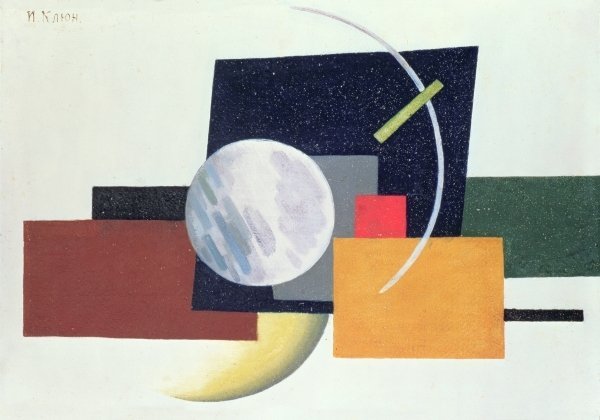On a titanium white canvas is a black, slightly tattered square, almost frozen in the middle of the pure-white background. The Black Square is probably one of the most well-known works of Kazimir Malevich. Its simplicity often strikes critics as lacking creative quality and thought. However, many do not realise that Malevich’s work has greatly influenced abstract art in the 20th century and even to this day. His overly-minimalistic perspective and dedication to his own style produced a new art concept: Suprematism, which focused on strict lines and simpler shapes. While surely controversial, abstract work undoubtedly possesses a deeper meaning behind it and is more than just a set of plain shapes. However, without Malevich’s influence on art, it is uncertain whether such art would even be acceptable in the modern age.
Kazimir Malevich was a Russian avant-garde artist and art theorist, Born in 1879, to a Polish family, Malevich spent a lot of his early childhood moving in the villages of Ukraine. It was not until the age of twelve that he uncovered the world of professional arts, taking pleasure in embroidery and painting. Several years later, he moved to Moscow, where he studied art at the Moscow School of Painting, Sculpture and Architecture. This would be something that would greatly affect his later career. During his stay there, Malevich took part in many exhibitions — allowing his work to be noticed and at the same time taking inspiration from other Russian painters.
At the time, he was greatly influenced by Russian avant-garde painters, who were particularly interested in Russian folk art. Their art depicts daily life, at times straying away from a realistic portrayal. Something that greatly influenced Malevich was his 1912 trip to Paris. This was his first encounter with Cubism, an art movement in which painters like Pablo Picasso reimagine reality in a more unrealistic and abstract form. Malevich applied these principles in his own artwork, setting off his success as a Cubo-Futurist painter. His stage-set in the opera Victory Over the Sun became a great success and Malevich’s name was becoming more recognised in the European art-scene as well.
However, his success did not end just there, as two years later, he set out to lay down the first foundations of Suprematism, a new creative concept. It focused on an even less realistic portrayal of life, applying simple shapes and bold colours to create an art piece. Publishing its principles in the manifesto, From Cubism to Suprematism, he inspired a new generation of Russian avant-garde artists. Some of the most well-known are Ivan Klyun and Ksenia Bouglavskaya: in their work, they focused on simple, geometric forms and mostly bright, primary colours. Malevich’s interest in aerial photography led him to work on pieces inspired by photos of landscapes taken from an aeroplane. Some of the most famous examples of his Suprematist works are Black Square and White On White; though well-known for their radical, abstract style, these pieces remain heavily controversial to this day. Many critics say they lack meaning or any creative value.
An example of Malevich’s work being pushed against was when Joseph Stalin prohibited the exhibition and creation of similar works. Some of Malevich’s pieces were confiscated. At the time, his work was considered too primitive and such that does not allow the viewer to interpret its meaning easily. In other words, Joseph Stalin was scared of Malevich and other abstract artists hiding secret political messages in his radical art. Little did the Soviet government know that their efforts have all been in vain. In just a matter of two decades, Malevich’s Suprematism has set the cornerstone for contemporary abstract artists.
There is no doubt that traces of Suprematism can be noticed in modern works. Malevich’s heritage lives on in the brushstrokes of 20th and 21st-century abstract painters. Some artists which employ some principles of Suprematism in their work are Davide Balliano, Robert Holyhead and Sarah Morris. His determination to change they way painters portray reality brought him immense fame and praise, perhaps not during his life, but after his death. Not only have his ideas spread to the West, mesmerising painters with their originality and collectors —with his work. In 2008, his Suprematist Composition has been sold for over US$80 million, surpassing his previous record of just US$17 million.
Abstract art is often heavily criticised for its lack of meaning behind the layers of paint on the canvas. However, others believe that this is exactly what makes abstract art special: its variety of interpretations allows the viewer to create the meaning themselves. This makes abstract art something that anyone can relate to. With its wide appeal, it does not require realistic depiction of the subject to convey a certain meaning. Moreover, geometric abstract art, heavily influenced by Malevich’s Suprematism, not only inserts the reality into a set of several simple shapes but also creates a visually-pleasing image due to the clean lines and bold colours. This is what makes abstract art so deep: not necessarily the painter’s skill at realistically recreating the scene, but his skills at using lines, shapes and textures to convey a much more subtle meaning.
It is hard to say what exactly captures the viewer’s attention when looking at Malevich’s art. Whether it is the simple composition, the use of bold primary colours or perhaps the lack of connection to reality whatsoever. His work has turned the tables for modern art, allowing a new wave of artists to enter the scene and take over. For Malevich, art was more than just delivering aesthetic pleasure to the viewer – with the concept of Suprematism, he expected to express the full spectrum of emotion that a human may feel. While there is still controversy surrounding the value of his art, there should be none surrounding the artistic influence he had on the art of the 20th century.
Photo via Artsy

















